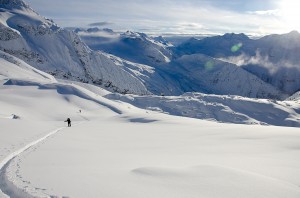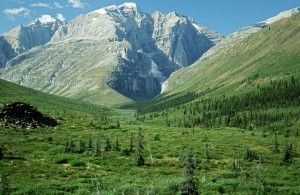Yellowstone to Yukon

Over twenty years ago, it was the saga of one wolf that set in motion an extraordinary vision – conserving the vast ecosystem stretching from Yellowstone National Park to the Yukon. Tracking the wide-ranging path of this wolf, brought home to the researchers the size of the terrain needed to support these apex carnivores. This ignited a bold idea to create an initiative – that building on existing protected lands – would eventually encompass a region that was big enough for wolves and grizzlies to roam. The idea was made real when a group of scientists and conservationists convened in Kananaskis, Alberta to identify the critical landscapes that should be connected in the region. The group concluded that there was an opportunity to link conservation goals from Yellowstone to the Yukon.
Today this effort known as the Yellowstone to Yukon Conservation Initiative (Y2Y) is a joint Canada-US organization that seeks to preserve and maintain the wildlife, native plants, wilderness and natural process of the mountain ecosystem. The Y2Y region includes two countries, five American states, two Canadian provinces, two Canadian territories, the reservation or traditional lands of over 30 Native governments, and a number of government land agencies. The project has to bridge many social, economic, historical and cultural differences between the diverse human communities within or near to the region. Y2Y offers education and stewardship programs that encourage conservation of the area. Y2Y has been named by the IUCN-World Conservation Union has as one of the planet’s leading mountain conservation initiatives for their science based approach to the landscape.

The Y2Y initiative links regional initiatives like the Crown of the Continent, which is arguably the most ecologically intact region in the southern portion of Y2Y. This complex of protected areas centering on Waterton Glacier International Peace Park (which straddles the US-Canadian border) is critical for maintaining high-quality, secure habitat for grizzlies, wolves and other wild life. Appropriate habitat cannot just be a small protected “islands”, wide migration corridors are needed so animals can travel to different parts of an ecosystem. The presence of these large protected areas is the main reason that the Crown of the Continent has more grizzly bears than any other place in the lower 48 states.

What began as a visionary effort to demonstrate the value of the vast mountain ecosystem stretching from Yellowstone National Park to the Yukon, is now grounded in 125 active partnerships to conserve land and steward the region’s natural resources. Over the past 20 years, protected public land in the Yellowstone to Yukon region has doubled to 20%. Y2Y serves as a global model of a nongovernmental led large landscape conservation effort.


